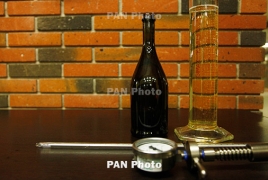Armenia - a viticulturist’s dream: Sommelier India October 30, 2017 - 10:30 AMT PanARMENIAN.Net - The wine magazine Sommelier India has prepared an article about winemaking and viticulture in Armenia, starting it with a story described in the Book of Genesis of how Noah, after disembarking from the Ark which saved him and all the other creatures from the great Flood thousands of years ago, was tasked with restocking a denuded earth, writes Kanika Dhawan. The Ark came to rest at the top of Mount Ararat, which is now the highest mountain in Eastern Turkey and was a part of Armenia until Turkey took it over. "Noah is said to have planted a vineyard at the foot of the mountain, harvested grapes, fermented them and become inebriated on too much of his own wine. In the book, “Ancient Wine: The Search for the Origins of Viniculture” by Patrick E McGovern, Scientific Director of the Biomolecular Archaeology Project, University of Pennsylvania Museum, there is a reference to wine in Armenia around the 8th century BCE. Inscriptions by the kings of Urartu who were settled around Lake Van (once part of southern Armenia, now in eastern Turkey) described Ararat Valley, Armenia’s key agricultural hub, as the “land of the vineyards”. Even the Greek historian, Herodotus, wrote about wine being transported from Armenia down the Rivers Euphrates and Tigris in the 5th century BCE," the article says. "Such references shed light on how long back winemaking started in Armenia. In 2011, a team of researchers from UCLA and the Armenian Institute of Archaeology and Ethnography, led by Armenian-American archaeologist Gregor Areshian, unearthed evidence inside the caves of Areni village in the rocky Vayots Dzor or “Gorge of Woes” region. The research team found a wine press, remnants of vines, seeds and vats with residue, dating back to the Copper Age, which was roughly 6,100 years ago." Armenia’s winemaking culture may have lapsed to some extent due to the ravages of war, but it’s back in full swing now with avant-garde wineries, post-communism vintners and snazzy wine restaurants spread across the country, the Indian magazine says. Lianna Abelyan, Head of Project Implementation, Vine and Wine Foundation of Armenia, says that wine continues to be an item of importance in the daily life of Armenians. “Wine is the main ingredient in all rituals in the church, as it is perceived as a symbol of Jesus’s blood. Since ancient times, we have used wine to bless grapes for a ritual called grape-blessing, after which the grape becomes wine; it is also used during weddings.” About 83% of this wine is produced in the Ararat Valley and Armavir region. The other four winemaking regions are Aragatsotn, Tavush, Syunik and Vayots Dzor. Today, more than 45 Armenian companies are making over 100 types of wine with indigenous and foreign varietals. Indeed, Armenia could be described as a viticulturist’s dream. Read also: Mobile 'Wine Cubes' could transform Armenia's enotourism: Smithsonian Related links: The number of state universities will be reduced from 23 to 8 by 2030, Minister of Education, Science, Culture and Sport Zhanna Andreasyan has said. From September 21 to November 11, a total of 2,820 Russians registered at a place of residence in Armenia, the police has said. The situation on the contact line between Karabakh and Azerbaijan was relatively stable overnight, the Defense Army says. Defense Minister Suren Papikyan has visited the southern Armenian province of Syunik, the Defense Ministry reported on March 18. Partner news |